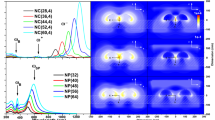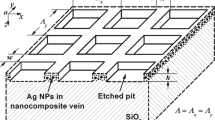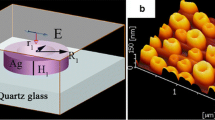Abstract
The optical property of three-dimensional (3D) hybrid nanostructures consisting of Ag-coated SiO2 nanorods (Ag-SiO2 NRs) is studied by a method of finite-difference time-domain calculations. In the visible-light to infrared band, the extinction spectra of single Ag-SiO2 NRs are basically dominated by three surface plasmon resonance (SPR) peaks. By calculating the electric fields of Ag-SiO2 NRs excited by the incident light in resonance with the three SRP peaks, the plasmons are identified to originate from the electronic oscillation located at the bottom, the side surface, and the top, respectively, different from the extinction behavior of spherical or semispherical Ag-coated SiO2 nanostructures. The extinction behavior of Ag-SiO2 NRs is also found to become obviously different from that of pure Ag NRs when the thickness of Ag layers is less than the penetration depth of incident light in pure silver. The plasmon coupling between the Ag-SiO2 NRs is investigated using the parallel and fork-like configurations. It is found that the parallel configurations exhibit the extinction spectra similar to those of single Ag-SiO2 NRs, while the plasmon coupling enables the local electric fields to be obviously enhanced, especially in the gap regions. For the fork-like configurations, the plasmon coupling between the Ag-SiO2 NRs results in the enhanced electromagnetic radiation normal to the polarization direction of incident light, forming the hybridized plasmons generated by the electronic oscillations with different nodes.
Graphical Abstract











Similar content being viewed by others
Availability of Code and Data
The code and datasets generated during the current study are available from the corresponding author on reasonable request.
References
Pendry J (1999) Playing ticks with light. Sci 285:1687–1688
Barnes WL, Dereux A, Ebbesen TW (2003) Surface plasmon subwavelength optics. Nature 424:824–830
Zayats AV, Smolyaninov II (2003) Near-field photonics: surface plasmon polaritons and localized surface plasmons. J Opt A Pure Appl Opt 5:S16–S50
Krenn JR, Leitner A, Aussenegg FR (2004) Metal Nano-Optics, Encyclopedia of nanoscience and nanotechnology 5:411–419
Maier SA (2007) Plasmonics: fundamentals and applications. Springer verlag, New York
Brongersma ML, Kik PG (2007) Surface plasmon nanophotonics. Springer verlag, Netherlands
Zhang HQ, Abhiraman B, Zhang Q, Miao JS, Jo KY, Roccasecca S, Knight MW, Davoyan AR, Jariwala D (2020) Hybrid exciton-plasmon-polaritons in van der Waals semiconductor gratings. Nature Comm 11:3552
Xie MC, Liu HY, Wan SS, Lu XX, Hong DC, Du Y, Yang WQ, Wei ZH, Fang SS, Tao CL, Xu D, Wang BY, Lu SY, Wu XJ, Xu WG, Orrit M, Tian YX (2022) Ultrasensitive detection of local acoustic vibrations at room temperature by plasmon-enhanced single-molecule fluorescence. Nature Comm 13:3330
Tavasoli A, Gouda A, Zähringer T, Li YF, Quaid H, Viasus Perez CJ, Song R, Sain M, Ozin G (2023) Enhanced hybrid photocatalytic dry reforming using a phosphated Ni-CeO2 nanorod heterostructure. Nature Comm 14:1435
Mock JJ, Barbic M, Smith DR, Schultz DA, Schultz S (2002) Shape effects in plasmon resonance of individual colloidal silver nanoparticles. J Chem Phys 116:6755–6759
Doering WE, Nie SM (2002) Single molecule and single nanoparticle SERS: examining the roles of surface active sites and chemical enhancement. J Phys Chem B 106:311–317
Kelly KL, Coronado E, Zhao LL, Schatz GC (2003) The optical properties of metal nanoparticles: the influence of size, shape, and dielectric environment. J Phys Chem B 107:668–677
Zhang JT, Li XL, Sun XM, Li YD (2005) Surface enhanced Raman scattering effects of silver colloids with different shapes. J Phys Chem B 109:12544–12548
Grand J, Adam PM, Grimault AS, Vial A, de la Chapelle ML, Bijeon JL, Kostcheev S, Royer P (2006) Optical extinction spectroscopy of oblate, prolate and ellipsoid shaped gold nanoparticles: experiments and theory. Plasmonics 1:135–140
Noguez C (2007) Surface plasmons on metal nanoparticles: the influence of shape and physical environment. J Phys Chem C 111:3806–3819
Munechika K, Smith JM, Chen YC, Ginger DS (2007) Plasmon line widths of single silver nanoprisms as a function of particle size and plasmon peak position. J Phys Chem C 111:18906–18911
Ringe E, McMahon JM, Sohn K, Cobley C, Xia YN, Huang JX, Schatz GC, Marks LD, Van Duyne RP (2010) Unraveling the effects of size, composition, and substrate on the localized surface plasmon resonance frequencies of gold and silver nanocubes: a systematic single-particle approach. J Phys Chem C 114:12511–12516
Khalil UK, Farooq W, Iqbal V, Kazmi SZUA, Khan AD, Rehman AU, Ayub S (2021) Design and optimization of bowtie nanoantenna for electromagnetic field enhancement. Eur Phys J Plus 136:754
Jamil S, Farooq W, Ullah N, Khan AD, Khalil UK, Mosavi A (2022) Large electromagnetic field enhancement in plasmonic nanoellipse for tunable spaser based applications. PLoS ONE 17:e0263630
Li XH, Chen GY, Yang LB, Jin Z, Liu JH (2010) Multifunctional Au coated TiO2 nanotube arrays as recyclable SERS substrates for multifold organic pollutants detection. Adv Funct Mater 20:2815–2824
Roguska A, Kudelski A, Pisarek M, Opara M, Janik-Czachor M (2011) Surface enhanced Raman scattering (SERS) activity of Ag, Au and Cu nanoclusters on TiO2 nanotubes/Ti substrate. Appl Surf Sci 257:8182–8189
Tan EZ, Yin PG, You TT, Wang H, Guo L (2012) Three dimensional design of large scale TiO2 nanorods scaffold decorated by silver nanoparticles as SERS sensor for ultrasensitive malachite green detection. ACS Appl Mater Interfaces 4:3432–3437
Tang HB, Meng GW, Huang Q, Zhang Z, Huang ZL, Zhu CH (2012) Arrays of cone shaped ZnO nanorods decorated with Ag nanoparticles as 3D surface enhanced Raman scattering substrates for rapid detection of trace polychlorinated biphenyls. Adv Funct Mater 22:218–224
Tao Q, Li S, Zhang QY, Kang DW, Yang JS, Qiu WW, Liu K (2014) Controlled growth of ZnO nanorods on textured silicon wafer and the application for highly effective and recyclable SERS substrate by decorating Ag nanoparticles. Mater Res Bull 54:6–12
Tao Q, Li S, Ma CY, Liu K, Zhang QY (2015) A highly sensitive and recyclable SERS substrate based on Ag nanoparticle decorated ZnO nanoflowers in ordered arrays. Dalton Trans 44:3447–3453
Sun Q, Zhang QY, Zhou N, Zhang LY, Hu Q, Ma CY, Zhang C, Yi Z (2020) Silver coated flower like ZnO nanorod arrays: ultrastable SERS substrates and the mechanisms of optical stability. Appl Surf Sci 526:146565
Sun Q, Zhang QY, Zhou N, Zhang LY, Hu Q, Ma CY (2021) FDTD simulation of Ag decorated ZnO nanorods for optimization of 3D SERS substrates. Appl Surf Sci 565:150524
Sun Q, Sun QW, Zhang QY, Zhou N, Zhang LY, Hu Q (2022) Effects of chloride ions on flower-like Ag-coated ZnO nanorod arrays and the Raman enhancement. Appl Surf Sci 578:152082
Oldenburg SJ, Jackson JB, Westcott SL, Halas NJ (1999) Infrared extinction properties of gold nanoshells. Appl Phys Lett 75:2897–2899
Westcott SL, Jackson JB, Radloff C, Halas NJ (2002) Relative contributions to the plasmon line shape of metal nanoshells. Phys Rev B 66:155431
Teperik TV, Popov VV (2004) Radiative decay of plasmons in a metallic nanoshell. Phys Rev B 69:155402
Prodan E, Radloff C, Halas NJ, Nordlander PA (2003) Hybridization model for the plasmon response of complex nanostructures. Sci 302:419–422
Sun QW, Sun Q, Zhang QY, Zhou N, Li XN (2022) Study on the plasmonic properties of Ag-coated spherical dielectric nanoparticles by finite-difference time-domain calculations. Plasmonics 17:265–276
Li XN, Sun QW, Zhang QY, Sun Q, Zhou N (2022) FDTD study of plasmonic antennas with metallic nanocap geometry for infrared applications. Plasmonics 17:1947–1956
Hu Q, Zhang QY, Hu BC, Zhou N, Yan PP, Chen J (2022) Structured green luminescence band of ZnO nanorods — the optical emissions coming from the sample surface. J Lumin 252:119433
Yan PP, Hu Q, Chen J, Zhou N, Zhang QY (2023) Gas sensing property of ZnO NR arrays stabilized by high-temperature annealing and the mechanism of detecting reduce gases. J Phys Chem Solids 181:111488
Yan PP, Hu Q, Chen J, Zhou N, Zhang QY (2023) Fabrication and optimization of ZnO NR sensors in-situ grown on ITO substrates by a solution method. J Alloy Comp 963:171225
Haynes CL, McFarland AD, Zhao LL, Van Duyne RP, Schatz GC, Gunnarsson L, Prikulis J, Kasemo B, Käll M (2003) Nanoparticle optics: the importance of radiative dipole coupling in two-dimensional nanoparticle arrays. J Phys Chem B 107:7337–7342
Hutter E, Fendler JH (2004) Exploitation of localized surface plasmon resonance. Adv Mater 16:1685–1706
Kinkhabwala A, Yu ZF, Fan SH, Avlasevich Y, Müllen K, Moerner WE (2009) Large single molecule fluorescence enhancements produced by a bowtie nanoantenna. Nature Photon 3:654–657
Palik ED (1985) Handbook of optical constants of solids. Academic Press, London
Zhang ZY, Zhao YP (2008) Optical properties of U-shaped Ag nanostructures. J Phys Condens Matter 20:345223
Funding
This work was supported by the Fundamental Research Funds for the Central Universities of China (Grant No. DUT19RC(3)057).
Author information
Authors and Affiliations
Contributions
All authors contributed to the study conception and design. Material preparation, data collection and analysis were performed by Jun-Ze Li, Xi-Na Li, Jie Chen, Nan Zhou, and Qing-Yu Zhang. The first draft of the manuscript was written by Jun-Ze Li and all authors commented on previous versions of the manuscript. All authors read and approved the final manuscript.
Corresponding author
Ethics declarations
Ethical Approval
Not applicable.
Consent to Participate
Not applicable.
Consent for Publication
Not applicable.
Competing Interests
The authors declare no competing interests.
Additional information
Publisher's Note
Springer Nature remains neutral with regard to jurisdictional claims in published maps and institutional affiliations.
Rights and permissions
Springer Nature or its licensor (e.g. a society or other partner) holds exclusive rights to this article under a publishing agreement with the author(s) or other rightsholder(s); author self-archiving of the accepted manuscript version of this article is solely governed by the terms of such publishing agreement and applicable law.
About this article
Cite this article
Li, JZ., Li, XN., Chen, J. et al. Extinction Behavior and Near-Field Enhancement of 3D Hybrid Nanostructures Consisting of Ag-Coated SiO2 Nanorods. Plasmonics (2024). https://doi.org/10.1007/s11468-024-02267-8
Received:
Accepted:
Published:
DOI: https://doi.org/10.1007/s11468-024-02267-8




